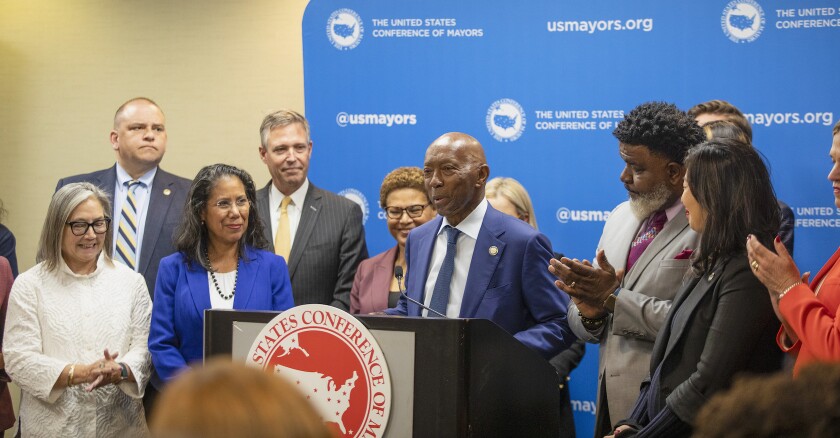In Brief:
Many see homelessness as a “wicked problem,” so complex it’s almost impossible to solve. But this begs a question: Shouldn’t the world’s wealthiest country, blessed with abundant space and smart enough to put a robot videographer on Mars, have what it takes to end it?
Mayors from 21 cities came to Los Angeles earlier this month to reconsider their homeless response at a meeting convened by the U.S. Conference of Mayors (USCM). “We have got to have the perspective that it’s unacceptable for people not to be provided with basic housing, health care, education and food,” said Los Angeles Mayor Karen Bass, chair of USCM’s Homelessness Task Force, at an afternoon press conference.
For two days, the mayors met in a series of sessions that provided opportunities to share best practices, homelessness research and priorities for federal advocacy. “We were elated that you would take this on,” said UCSM President Hillary Schieve, mayor of Reno, Nev., to Bass. “It takes a very tough mayor, but it also takes a mayor that understands that we have to call out when our policies are failing.”
The U.S. Department of Housing and Urban Development (HUD) hasn’t released its 2023 homeless assessment, but stakeholders expect it to show an increase of about 10 percent over 2022. That would be a significant change compared to the .3 percent increase seen over the previous two years.
The Los Angeles Homeless Services Authority (LAHSA) found an increase of about 10 percent in its 2023 homeless count. LAHSA estimates the homeless population in the county to be 75,518, with 46,620 of these in the city of Los Angeles.
“It’s an honor to come together and to share stories because we all learn from each other,” said Bass. “We take what we learn back to our cities, and that’s the way we are going to resolve this crisis.”

(Gary Coronado/TNS)
No Tribes
At the press conference, Wade Kapszukiewicz, mayor of Toledo, Ohio, spoke of the “three kinds of people” in the world: Democrats, Republicans and mayors. “We don’t have time for ideology, partisanship, red state, blue state, all that silliness,” he said. “Our conversation has gone in a lot of different directions today, but at the end of the day, we are about coming up with solutions.”
The solutions discussed included federal resources such as housing vouchers, emergency rental assistance and other protections against evictions. Federal infrastructure investments did not do much to help cities with housing shortages, Kapszukiewicz said. The country needs about 7 million more affordable housing units; in addition, it is losing as many as 15,000 public housing units each year. The units that remain need capital improvements in the range of $70 billion.
Houston Mayor Sylvester Turner, who has gained national attention for success in reducing his city’s homeless population, was among the mayors at the task force meeting. Tishaura Jones, the mayor of St. Louis, Mo., commended Turner for bringing stakeholders in his city together, so they could “lock arms” to address homelessness. “We can all do that back in our respective communities,” she said.
Turner, whose second term will end at the beginning of January, said he had “decommissioned” 113 homeless camps while in office and reduced the homeless population 65 percent, with 90 percent still housed after two years. “It takes a collaborative effort — cities, counties, states and the federal level.”
Mental health emerged as another concern at the meeting. “We looked at that as one of the key drivers, but it’s a chicken and egg,” Bass said. “You can have a mental health problem that led to you being unhoused or being unhoused can compromise your mental health.”
The “housing first” approach embraced by the field might be better described as “housing and,” says Jones. “It’s more like housing and health care, housing and mental health, housing and other support services. Where we’ve seen it most successful is in our tiny home village, which has wraparound services provided by one of our contractors.”

(City of Los Angeles)
Not a New Problem
Each city is unique, and even if one city’s experience can’t be translated directly to another, the tactics and strategy can, says Santa Monica Mayor Gleam Davis. Because of this, it’s possible that the task force could eventually develop a “handbook” for dealing with homelessness.
From 1983 to 2013, actor and writer Harry Shearer hosted a program on Santa Monica Public Radio station KCRW. He introduced “Le Show,” a mix of political satire, comedy sketches and music, as coming to listeners from “the home of the homeless.”
Davis is far from offended by this phrase. “I actually quote him quite frequently because there is a perception that homelessness is a new problem, and he started using that phrase 30 years ago. This isn’t a new problem, it’s a problem that’s changed over time, a problem that is metamorphosizing, and the challenge is how we stay one step ahead of it.”
At the opening of a roundtable discussion that followed the press conference, Neera Tanden, the director of the United States Domestic Policy Council, announced two new steps the Biden administration is taking to support cities in the work to reduce homelessness. “I'm thrilled to be here at this U.S. Conference of Mayors convening on homelessness because I really hope this can be a way in which we have a sort of two-way street.”
HUD, she said, will issue guidance to streamline access to funds in the Housing Choice Voucher program. HUD is also launching an “accelerator” to support those who want to expand the use of Medicaid to address housing problems. “That’s the kind of work that we are trying to do to ensure that we can be great partners to mayors, and not hurdles.”












